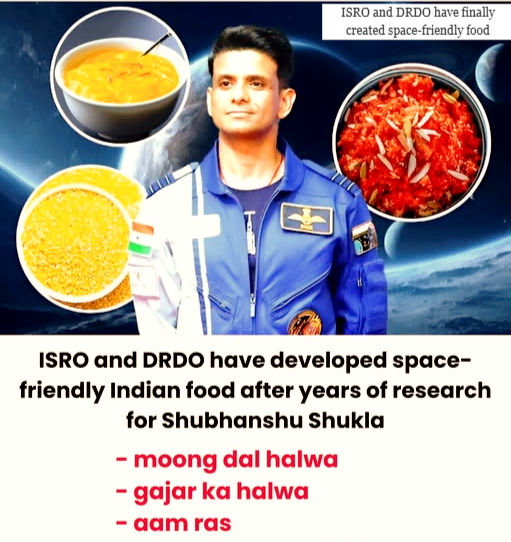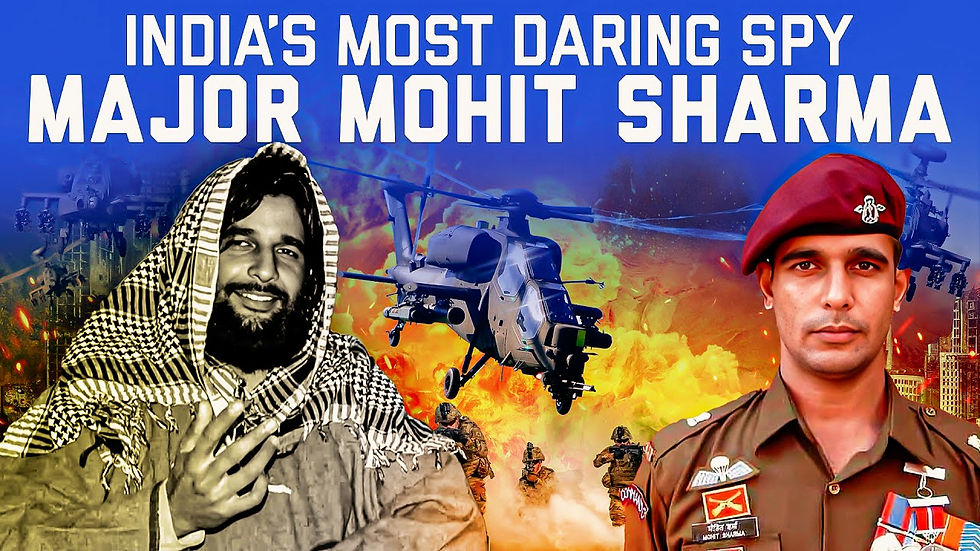🇮🇳 India Is Taking Halwa to Space: Desi Delights Now Orbiting the Stars 🌌🚀
- telishital14

- Jun 21
- 3 min read
In a move that blends tradition with technology, the Indian Space Research Organisation (ISRO) and the Defence Research and Development Organisation (DRDO) have achieved something truly out of this world — quite literally! For the first time in history, Indian sweets are heading to space, proving that innovation doesn’t have to come at the cost of cultural identity. 🌍✨
Yes, you heard that right. Moong Dal Halwa, Gajar Ka Halwa, and even Aam Ras — all iconic Indian delicacies — are now ready to be consumed 250 miles above Earth aboard the International Space Station (ISS). 🇮🇳🚀

🧑🚀 The Mission: Flavor Meets Function
Indian astronaut Shubhanshu Shukla will be the first to taste-test these desi treats in space. But this mission isn’t just about indulgence — it's a scientific breakthrough that represents years of R&D by DRDO and ISRO to create space-grade Indian food.
For decades, space food has been synonymous with dehydrated pouches, nutrition bars, and freeze-dried mystery meals. Functional, yes. Delicious? Not so much. But now, Indian scientists are changing the menu.
🔬 The Science Behind Space Halwa
Preparing food for space is no walk in the galactic park. Here’s everything that goes into making space-friendly halwa:
1. Preservation without Compromise
In space, food needs to:
Stay fresh for long durations (up to 12–18 months)
Retain nutritional value
Be compact, lightweight, and safe
To meet these criteria, ISRO and DRDO used a combination of:
Retort packaging technology (high-temperature, high-pressure sterilization)
Freeze-drying to remove moisture while retaining texture and flavor
Vacuum sealing to prevent contamination and spoilage
This ensures the food is shelf-stable, bacteria-free, and space-suitable 🚀.
2. Taste Test: Earth vs. Space
Before any item gets approved for zero gravity, it goes through rigorous sensory and scientific evaluations:
Texture testing (can it be eaten without crumbs floating everywhere?)
Odor containment (aromas can overwhelm the enclosed ISS environment)
Nutrient balance (astronauts need a specific macro and micronutrient profile)
Indian delicacies like Moong Dal Halwa and Gajar Ka Halwa passed these tests thanks to meticulous preparation and adaptation techniques.

🧁 The Stars of the Menu
Let’s take a closer look at the trio of delights heading to orbit:
🌟 Moong Dal Halwa
A rich, buttery sweet made from ground lentils, ghee, sugar, and cardamom. It had to be adapted to reduce excess oil and enhance fiber while still retaining the authentic grainy texture. 🟡✨
🥕 Gajar Ka Halwa
This carrot-based dessert is loved across India. For space, it’s made using dehydrated grated carrots, milk solids, and jaggery instead of sugar to boost nutrition. Beta-carotene = astronaut vision booster! 👩🚀🥕
🥭 Aam Ras
Mango puree — thick, golden, and delicious. Scientists ensured it had no added water (which is a hazard in space) and was sealed in retort pouches that could be sipped directly. Think of it as a mango smoothie from space. 🥭🚀
🧪 Who Made It Happen?
This innovative culinary feat is a joint effort between:
ISRO’s Space Applications Centre
DRDO’s Defence Food Research Laboratory (DFRL) in Mysuru
The DFRL has previously developed rations for soldiers at extreme altitudes and now they're serving astronauts. The food was developed under the Gaganyaan mission’s dietary program — India's flagship human spaceflight initiative.
🌍 Why This Matters: Beyond the Taste
🌐 Cultural Significance
Carrying Indian food to space is a symbolic assertion of India’s soft power, showcasing the blend of tradition and technology.
🛰️ Scientific Innovation
Developing space-grade Indian food involves cutting-edge research in:
Food preservation
Nutraceuticals
Aerospace hygiene
🍛 Future Possibilities
If successful, this initiative could lead to customized cultural menus for astronauts from different nations, making long missions more humane and less monotonous.

👨🚀 Astronaut Shubhanshu Shukla: The Man With a Sweet Tooth in Space
Shukla will not only be India’s representative on the ISS but also its culinary ambassador. Imagine floating in zero gravity, savoring spoonfuls of warm halwa while looking at Earth from above — it's poetic, futuristic, and uniquely Indian.
🗣A Bite of Bharat in the Beyond
This isn’t just food — it’s flavorful patriotism. While Western space programs brought us Tang and protein bars, India’s contribution now includes ghee-laced halwa and mango nectar.
What once required high-tech labs and astronauts in suits is now flavored with memories of home, culture, and comfort. 🌌🫶
India is not just racing to space — it’s bringing tradition along for the ride.
🚀🇮🇳 Desi Delights. Cosmic Heights.
#ISRO #DRDO #SpaceFood #IndianAstronaut #HalwaInSpace #MoongDalHalwa #GajarKaHalwa #AamRas #MadeInIndia #SpaceInnovation #AstronautMeals #IndianCuisine #ISS #Gaganyaan #SpaceExploration #DesiInSpace




Comments